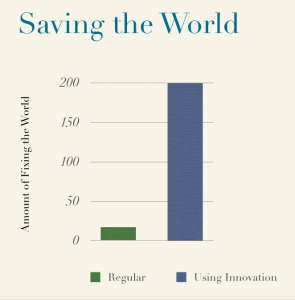
By Tom Peterson
Jonas Salk asked, “What must we do to evoke the greatest potential from ourselves and from others?” Here’s a great starting point: a strong culture of innovation. That should result in better programs, stronger revenue streams, scaling up and revolutionary solutions to challenges.
Note in the chart (right) the increased world fixing through innovation. Okay, I made that up. But this is not made up: A truly creative group will surpass its own imagination. So, how do you create a culture of innovation? Following these ten practices should help you get there.

1. Start with—and appreciate—what you have.
“If only we had an angel donor. If only _____ (fill in the blank with really rich local person) would realize how good we are and give us serious funds.” Many nonprofits feel they don’t have enough resources to do their mission. If only…
While challenging, having limited funds doesn’t determine the future. In fact, most groups have more than they realize, enough to go to a new level. Limitations open possibilities. Necessity, said Plato, is the mother of invention. With creativity and perseverance you can move mountains with small inputs.
Innovative groups constantly scan, look for that “bright spot” that “positive deviance.” Why does this small thing over here work so well? Instead of fixating on (then trying to fix) problems, look for what’s going well and build on that.
Appreciative inquiry is a process that ferrets out positive things and asks, how do we build on this? Has a group of volunteers come up with successful fundraising program that could be scaled up? Is one of your program units getting better than average results? Why? What are the positive outliers? What surprised you in a good way? What people seem to be especially helped by the program?
Giant Blank Canvases. In 2009 Tony Goldman was trying to find a way to revitalize a district of abandoned warehouses in Miami. He realized they had one asset in abundance: blank walls. So they invited artists to paint murals to create Wynwood Walls, a giant outdoor art museum and attraction. Now dozens of internationally known muralists, graffiti artists have created a multi-block district of amazing art.
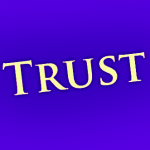
2. Build Trust.
To accomplish truly great things your team and partners should be able to trust each other as they would the surgeon getting ready to cut them open. You can innovate only as well as you can trust. You have to slog away on building that trust, every day, in every encounter, each step forward. So how do you create a trusting environment?
Leaders and others have to be committed to, and model, a true environment of trust. • Be clear about the shared vision, the big goals. Communicate the expectations and the direction as much as it takes so everyone is clear. • Begin with transparency and open discussion. Learn to say the hard things. Share your concerns, as well as dreams. • Keep confidential things that should be confidential.
Really listen to what others have to say; actually learn from them. • Appreciate openly what each person brings to the table. Acknowledge the contributions of others. • Show trust in your coworkers. Treat a team member’s misstep or mistake not as cause for reprimand, but as a learning opportunity. • Be accountable, do what you said you would do. And hold others accountable for doing what they said they’d do. • Learn to ask for help. Often seen as a weakness, asking for help—and being ready to help when asked—is a great way to build trust.

3. Operate in Permanent Beta.
Got a new idea that might make a big difference? Don’t wait until it’s fully developed, go ahead and toss it into the real world to see what happens. When software developers release a new program or update before it’s fully tested they use the term Beta. Select customer/beta-testers feed back information that helps developers improve the program before the actual launch.
Make the not-yet-tested-and-perfected change and learn from it. In The Start-up of You, LinkedIn founder, Reid Hoffman, and Ben Casnocha call this permanent beta:
Technology companies sometimes keep the beta test phase label on software for a time after the official launch to stress that the product is not finished so much as ready for the next batch of improvements. Gmail, for example, launched in 2004 but only left official beta in 2009, after millions of people were already using it.
Be nimble, put your ideas on out there quickly and too early so your team can explore, test, fail, and improve. Read More Here.

4. Think Flywheel.
A culture of innovation isn’t simply where people come up with brilliant ideas. It’s thinking and acting for the long term, incremental improvement over time.
The flywheel concept from Jim Collins’s Good to Great is about qualitative changes made year after year. More than coming up with that one brilliant idea, that one lucky connection, it’s showing up day after day, year after year and incrementally improving. Says Collins:
No matter how dramatic the end result, the good-to-great transformations never happened in one fell swoop. There was no single defining action, no grand program, no one killer innovation, no solitary lucky break, no wrenching revolution. Good to great comes about by a cumulative process—step by step, action by action, decision, turn by turn of the flywheel—that adds up to sustained and spectacular results.
Forward moving incrementalism can be powerful. Constantly look for ways to improve programs and products. Heifer International’s gift catalog raises tens of millions of dollars annually. Its success stems from a string of at least two-dozen unique and significant improvements over many years. The catalog program was in permanent beta.
Work for the long haul. Think years. Wendell Berry tells us to plant sequoias.
A Video, Links and More about the Flywheel Here.

5. Obsess over Talent.
Nothing squelches innovation more than stiff hierarchy and bureaucracy. Where rules rule, the best people either suppress their creativity or leave. The same is true when just a few personalities dominate. Also, while I’m on this jag, get rid of the cynics; one person’s negativity can stifle the happy creativity of an entire group. All of these are poisonous whether your organization is five people or 200. Sorry to be such a downer. But if you want a culture of innovation, you’ve got to fix all of these.
Talent is everything, by far your organization’s most important asset. Great talent is the difference between mediocrity and heroic success. So every position you have is a precious gift. You want to be on a team of people who are bright, happy, kind, fun, energetic, enthusiastic, curious, zany and awake.
Structure jobs and processes as flatly as possible. Liberating Structures is one tool that when used over time will help you make this shift. Ultimately, you want your organization to be a liberating and liberated structure.

6. Encourage Wow Projects
This idea from Tom Peters: take on some drab assignment no one else wants and turn it into something that makes people say Wow! Or you may have an idea you’re passionate about, at work, at home, anywhere. How can you turn that into something amazing? An organization where Wow Projects are encouraged and common will have a culture of innovation.
The point, says Peters, “is not to do a ‘good job’ of managing the project that your boss dumped into your lap. It’s to use every project opportunity that you can get your hands on to create surprising new ways of looking at old problems.”
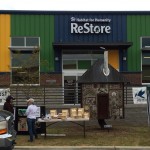
7. Focus on Benefit Exchange.
You get this, we get that. Successful nonprofits have found ways that supporters get something valuable when they donate or volunteer. Quid pro quo. Innovative organizations constantly look for new ways to create win/win for others. How can a potential partner win as they help move the cause forward?
Habitat for Humanity’s ReStore outlets have created an entire ecosystem of winners: bargain-hunting customers; people getting rid of clutter; companies and builders getting rid of excess supplies; and, of course, low-income families who end up in a new affordable home.
Find a way to generate funds that solves someone’s need. Fundraising catalogs can conveniently solve the problem of what to get Aunt Sue (who already has everything) for Christmas. Thin Mints Girl Scout cookies can… oh, did I say need? Okay maybe sometimes you’re solving a want.
Find that compelling benefit exchange to really grow your revenue base. Then other resources follow. This let’s you escape operating in an atmosphere of scarcity. Just a few extra resources changes the entire mood and atmosphere. The starting point for this is finding win-win scenarios. Ask in a thousand ways: who could possibly benefit (win) when they help us reach our goals?
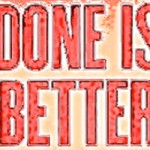
8. Practice Done is Better Than Perfect.
This means people get work done and push it out the door. The phrase done is better than perfect became a mantra in Facebook’s “hacker culture.” Mark Zukerberg explained it like this:
Hackers try to build the best services over the long term by quickly releasing and learning from smaller iterations rather than trying to get everything right all at once. To support this, we have built a testing framework that at any given time can try out thousands of versions of Facebook. We have the words “Done is better than perfect” painted on our walls to remind ourselves to always keep shipping.
As your team creates projects and campaigns to improve the world, shoot for not perfect but done. Yes, you should develop your programs as well as you can. But will any of the work be perfect? Not likely. But what is?
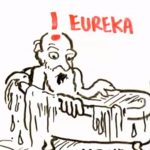
9. Encourage Fun, Flexibility & Free Time.
If you want the creatives to stick around, you’ve got to have a place where people laugh, enjoy, play. If your team is truly motivated to do something great, you can believe that even if you can’t see them, they will keep moving forward. Workplace flexibility is a key to a culture of innovation and helps people work on their projects at different paces. Remember, we’re not all wired the same. Your team’s best ideas may come at odd times and in unexpected places (like on walks or in bathtubs). Some groups give their employees a percent of their time to work on any special project they’d like to explore.
10. Target the Outcome.
Keep your eye on the prize. Innovation for its own sake is a meaningless distraction. Be clear about your target, your goals, what you’re trying to accomplish, so the innovation focuses on getting you there.
Make sure people are clear about the vision, the direction.Then protect them from endless meetings and mindless bureaucratic tasks. Turn them loose; they will find the way to make it happen. Figure out how to measure the important things and let the rest go.
Culture of Innovation: Invest in It.
Most nonprofit staff are already going full speed, so simply adding “innovate” on to their load won’t work. Follow these paths and others to invest in creating the culture of innovation. Make it an organizational core value, and you will vastly raise your world-fix quotient. And you’ll enjoy the journey more!
Photos: Creative Commons: Flywheel, Newtown graffiti; Quilt, Glenys Gaske; Target, Brent.


No comments yet.